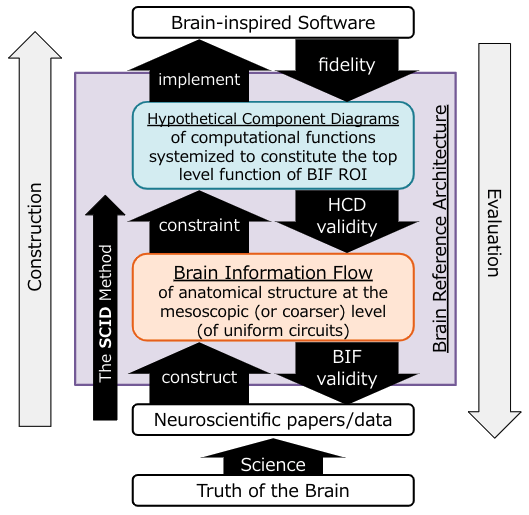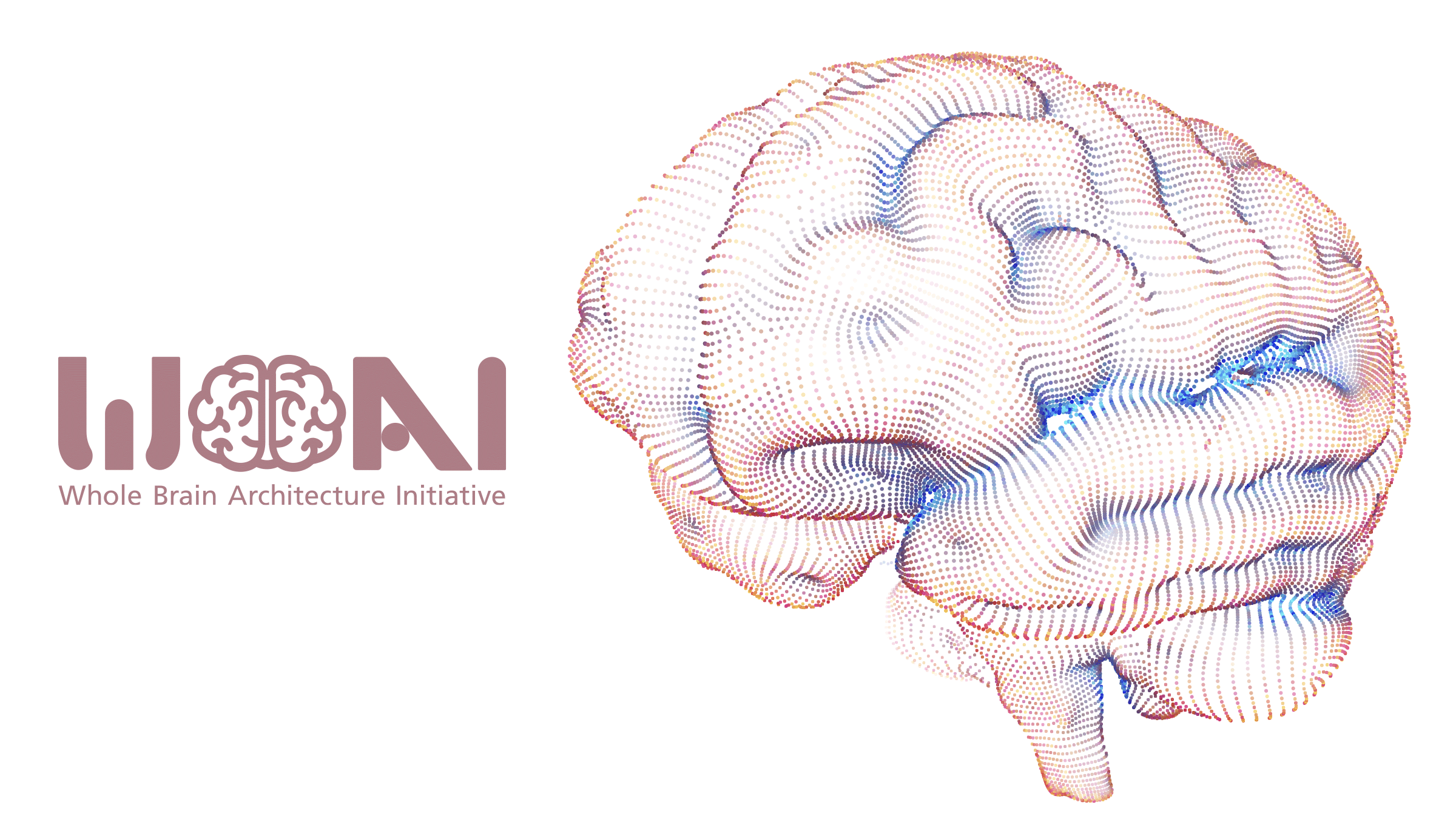Our activities in Fiscal Year 2021 (from April 2021 to March 2022 — the sixth year) include educational and R&D businesses, implemented according to our policy for FY2021.
Educational Business
The goal of our educational business is to help people who conduct research on the WBA approach on a long-term basis. In FY2021, WBAI held the sixth WBA symposium, two WBA seminars, and two WBA lectures (in Japanese). Videos of the paid WBA seminars are distributed on Vimeo for a fee, and those from free events are distributed on YouTube.
The Sixth WBA Symposium
The symposium was held (in Japanese) online on September 10, 2021 with the theme of “Toward Brain-inspired AI Coexisting with Humans” with speakers Masahiko Inami (The University of Tokyo), Takehiro Ohya (Keio University), Satoshi Kurihara (Keio University) and discussion with Koichi Takahashi (RIKEN, WBAI) and Hiroshi Yamakawa (WBAI). There were also presentations by Hiroshi Yamakawa and Naoya Arakawa (both WBAI).
It was organized by WBAI and supported by the MEXT project: “Brain information dynamics underlying multi-area interconnectivity and parallel processing.”
In the symposium, Ayako Fukawa was conferred the WBA Incentive Awards with her engagement in establishing the SCID method for BRA construction, and awards for Meritorious Service were presented to Naoyuki Sakai for his contributions to media/public relations, marketing planning, and regular reporting to supporting members, and to Satoshi Ueno for his contributions to the WBA Seminars Executive Committee (formerly known as the Supporters), by founding it and serving for it as chair.
WBA Seminars
In FY2021, WBAI held two seminars (in Japanese) with the following themes and speakers.
- 32nd Seminar: May 26, 2021, Cognitive Development and Developmental Disorders Based on General Principles of the Brain
with Yukie Nagai and Shin’ichiro Kumagai (both from The University of Tokyo)
- 33rd Seminar: June 25, 2021, Is Biologically Plausible Agent Interaction Promising? – Prospects for Intelligence Research from HAI and WBA
with Masahiko Osawa (Nihon University), Takafumi Sakamoto (Shizuoka University), and Yoshimasa Tawatsuji (Waseda University)
WBA Lectures
- 2nd Lecture: June 13, 2021, Let’s Run Memory Architecture Imitating the Brain!
Naoya Arakawa (WBAI), Yuki Onodera
- 3rd Lecture: November 17, 2021, Experiences in building a brain-inspired machine learning model: on what scaffold was a hippocampus-like probabilistic generative model built?
Ayako Fukawa (WBAI), Akira Taniguchi (Ritsumeikan Univ.), Yoshimasa Tawatsuji (Waseda Univ.), Hiroshi Yamakawa (WBAI)
The Fifth WBA Hackathon — Beyond ‘now and here’ —
Between May and October 2021, an online hackathon was held together with Cerenaut, WBAI’s partner, to create a whole-brain architecture agent that solves tasks with working memory.
R&D Business
The goal of our R&D business is to support research activities in the WBA approach.
Brain Reference Architecture (BRA) Driven Development
BRA-driven development is a methodology for building AGI in the whole-brain architecture approach, allowing hypotheses to be built on a relatively wide range of brain functions that are not necessarily obvious. WBAI has been promoting research and development of brain-inspired AGI through BRA-driven development since FY 2018.
BRA-driven development uses the Brain Information Flow (BIF) diagrams based on the mesoscopic anatomical structure of the brain related to human cognitive behavior, and hypothetical component diagrams (HCDs), which describe computational functions consistent with the BIF (see the figure below).
Currently, we are working on BRA evaluation methods, BIF creation from connectome, development of a BRA description environment, BRA creation, HCD integration, and implementation of brain-inspired software, each of which is described in the following sections. The projects financially supported by the MEXT project “Brain information dynamics underlying multi-area interconnectivity and parallel processing.” are described as (BID). Figure 1: Brain Reference Architecture (BRA) -driven Development
Figure 1: Brain Reference Architecture (BRA) -driven Development
BRA Evaluation Methodology
BIF data need tests to ensure the credibility of their projection information. For such a method is not available at this stage, we attempted to create data to evaluate the credibility, and found that the data creation takes approximately 1 hour per projection (BID). We also systematized concepts in BRA-driven development.
BIF Creation from Connectomes
Since we are aiming for human-like AGI, it is desirable to use human connectomes in describing the BIF for the basis for BRA-driven development. However, we have to use information from other animals for anatomical information that is not available in the human brain, and so decided to create “SHCOM” connectome as defined below. In FY2021, we conducted a basic survey to collect connectomic information on humans and other mammals in order to create a neocortical SHCOM (BID).
Supplemented Human Connectome with Other Mammals’ (SHCOM)
SHCOM is the most probable hypothesis about connections between brain regions at the mesoscopic level, the (average) number of axons, their directions, and in the neocortex, the feedback/feedforward directions, for the human brain.
Development of BRA description environment
From the viewpoint of efficient data production by BRA design projects working together in the future, we investigated the current workflow and proposed improvements, especially in the BIF creation process and its deliverables. We also created a validation script for BRA data written by the creator of the BRA (BID).
BRA creation
We created BIFs for the cerebellum, eye movements, the claustrum, conscious architecture, and speech-language segmentation.
HCD integration
Once BRAs for various brain areas are constructed, HCDs are described on the master BIF. So, it is necessary to integrate the HCDs into a consistent HCD for the entire brain, to construct the Whole Brain Reference Architecture (WBRA). In FY2021, this issue was pointed out and studies toward the construction of the WBRA were initiated.
Implementation of brain-inspired software
As the whole brain BRA is not complete, it is not possible to directly implement WBA as a system. Meanwhile, we are conducting a brain-inspired software implementation in advance to make trials, evaluate, and determine the underlying framework and models, to confirm the feasibility of software development from HCD, and to further examine the biological plausibility of the software (BID).
As an application of BriCA, a general-purpose software platform for cognitive computing, we have implemented a combined learner consisting of models of the neocortex and basal ganglia loops (BID).
In a verification implementation of software design based on HCD, we found that the difficulty for implementers of selecting computational models and that information such as the coordinate system to use, dimensions, and time constants is often lacking in current HCD (BID).
Collaborating with local research groups (R&D promotion)
WBAI has been collaborating with other organizations to develop research infrastructure such as software to support research using the WBA approach. In FY2021, we conducted collaborative activities in the following research and development. In particular, we developed the concept of the Whole Brain Probabilistic Generative Model (WB-PGM) in collaboration with the Grant-in-Aid for Scientific Research on Innovative Areas “Correspondence and Fusion of Artificial Intelligence and Brain Science” and published a paper.
Activities to make AGI Beneficial
Because of the potentially large impacts of AGI on humankind, we are conducting activities to make it beneficial, safe, and democratized.
WBAI Activities and Volunteering
WBAI activities such as WBA seminars have been conducted with non-paid volunteers including regular members, except for a paid part-time worker at the secretariat.
Financial Statements for FY2021
The balance sheet and cash flow for FY2021 are presented below (Table 1 and Table 2).
The revenues were 1.80 million yen and the expenditure totaled 0.81 million yen for administration and 1.30 million yen for operation (total expenditure was 2.11 million yen to yield 0.31 million yen deficit).
The businesses of WBAI have been financially supported by supporting members. (As of March 2022, there were nine supporting members consisting of enterprises and individuals.) The other incomes include fees from the participants of the WBA seminars.
Honoraria were paid to the speakers of the WBA Seminars. The subcontractor/outsourcing expenses for operation includes the cost of R&D, which was mostly carried out with the budget of exterior research institutions. Prize was paid to the awardee of the WBA Incentive Award.
The expenses for secretariat personnel (shown in Subcontracting/outsourcing Expenses) were apportioned by 50% (50/50) for operating and administrative expenses. The remuneration was paid to an accountant office. The rent for the office was free of charge by courtesy of Garm Inc.
Table 1: Balance Sheet (as of March 31, 2022)
| Items | Amount (JPY) | ||||
| Ⅰ
|
Assets | ||||
| 1. | Current Assets | ||||
| Cash and Saving Account | 8,836,959 | ||||
| Total Current Assets | 8,836,959 | ||||
| Total Assets | 8,836,959 | ||||
| Ⅱ
|
Liabilities | ||||
| 1. | Current Liabilities | ||||
| Advance Received | 400,000 | ||||
| Withholding Taxes | 6,126 | ||||
| Total Current Liabilities | 406,126 | ||||
| Total Liabilities | 406,126 | ||||
| Ⅲ
|
Net Assets | ||||
| Retained Net Assets at the Beginning of Period | 8,739,608 | ||||
| Net assets variation | -308,775 | ||||
| Total Net Assets | 8,430,833 | ||||
| Total Liabilities and Net Assets | 8,836,959 | ||||
Table 2: Cash Flow
| Items | Amount (JPY) | ||||
| Ⅰ
|
Recurring Revenues | ||||
| 1 | Fees | ||||
| Fees from Regular Members | 180,000 | ||||
| Fees from Supporting Members | 1,520,000 | ||||
| Total Fees | 1,700,000 | ||||
| 2 | Other Revenues | ||||
| Interest Income | 73 | ||||
| Other Income | 98,374 | ||||
| Total Recurring Revenues | 1,798,447 | ||||
| Ⅱ
|
Ordinary Expenses | ||||
| 1 | Operating Expenses | ||||
| ⑴ | Total Personnel Expenses | 180,55 | |||
| ⑵ | Other Expenses | ||||
| Honoraria | 154,000 | ||||
| Subcontractor/outsourcing Expenses | 737,000 | ||||
| Communication | 175,023 | ||||
| Prizes/Awards | 50,000 | ||||
| Other | 1,564 | ||||
| Total Other Expenses | 1,117,587 | ||||
| Total Operating Expenses | 1,608,453 | ||||
| 2 | Administrative Expenses | ||||
| ⑴ | Total Personnel Expenses | 0 | |||
| ⑵ | Other Expenses | ||||
| Subcontractor/Outsourcing Expenses | 528,000 | ||||
| Remuneration | 264,000 | ||||
| Other | 17,082 | ||||
| Total Other Expenses | 809,082 | ||||
| Total Administrative Expenses | 809,082 | ||||
| Total Ordinary Expenses | 2,107,222 | ||||
| Net Assets Variation of the Year | -308,775 | ||||
| Net Asset brought forward | 8,739,608 | ||||
| Net Asset carried forward | 8,430,833 | ||||



 Japanese
Japanese